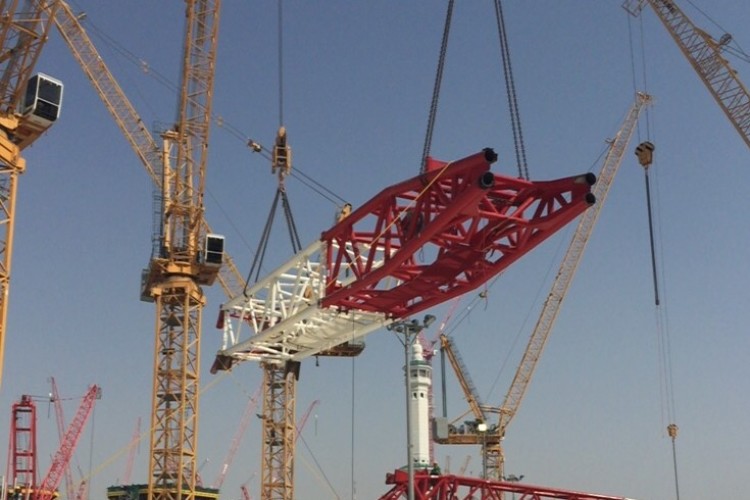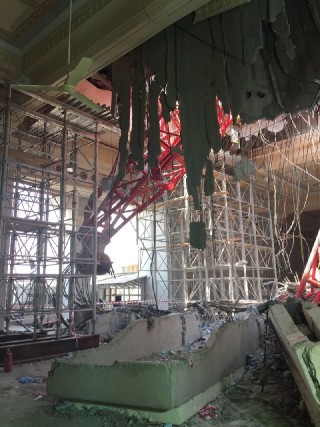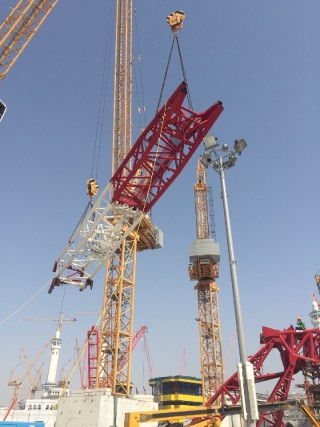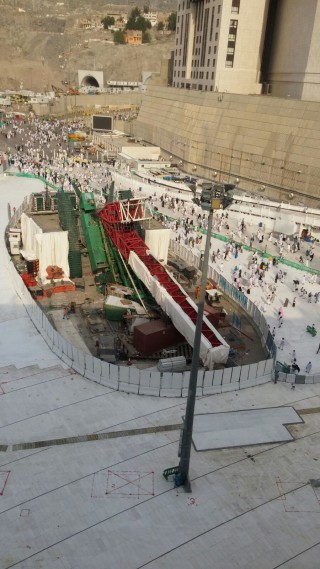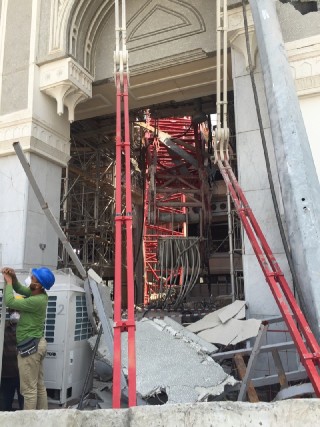Details of the collapse – which killed 109 people - and photographs of the clean-up operation have been published by Saudi Aramco, which was brought in as part of the task force investigating the accident and recovering the site.
Only the crane crawler’s body now remains in its place, barricaded off to maximise space for pilgrims to enter the mosque.
The accident
The collapse happed on 11th September 2015 after prayers in Mecca, the holiest city in the Muslim world. Weather condition changed suddenly winds reach 88 km/h and the crane location was effectively in a in wind tunnel corridor.
Contractor Saudi Bin Ladin had erected its LR 11350 Liebherr crane with its full 84m luffing fly as well as the full 102m main boom for construction work inside the mosque. Most of the construction works were completed a year ago; only small sections remained. The crane fell above the Massa, a three-storey route inside the mosque, measuring some 400m long by 20m. All pilgrims walk this route seven times as part of their main duties when they arrive and prior to their leaving.
The crane was placed to build the 2nd and 3rd floors of the Massa, which is being expanded to cater for a projected increase to five million pilgrims from this year’s two million. Its main boom was placed at an angle of 85° ready to resume construction after the pilgrimage season. This was against the manufacture instruction of keeping the boom horizontal at ground level while it is not in use.
The crane boom landed on the mosque during a storm. The hook block snapped out of the boom into the middle of the mosque, killing 109 people and injuring many more.
Liebherr’s statement
Liebherr has put out a statement saying that the crane itself was technically faultless. “According to the findings of the Liebherr crane experts sent to Saudi Arabia the LR 11350 was erected at the time of the accident with a boom length of approximately 190m, parked outside of the Grand Mosque and put out of operation. Previously it had sporadically been used for assembly works. In the late afternoon of 11 September 2015, during a strong thunderstorm and sandstorm with measured wind speeds of 80km/h (according to the CNN Weather Service) and 105km/h (wind recording of a Liebherr Tower Crane near the place of accident), heavy rain falls and a sudden drop in temperature by 20⁰C, the crawler crane was caught by the wind and tilted over the last support rollers of its crawler tracks.
“The operating instructions of the LR 11350 and the associated ‘Wind Speed Charts’ show that the crawler crane could not withstand such a high wind load and that the boom should have been lowered to the ground preventatively to avoid the tilting of the crawler crane."
Removing the collapsed crane
The 20t jibs that fell on the mosque’s roof were lifted with assistance of a 50t tower crane (HC-L 335) and one of 60t (540 HC-L). The main challenge was the shape and location of the W-section that had penetrated through the roof and entered two levels of the building. Consultant Dar helped the contractor in designing a shoring system to transfer the load into the column and beams to reduce the weight on the roof.
.png)
Mammoet supported the project by designing the lift plan. Also, the firm also designed a 6m-high wall supported with concrete blocks to prevent the crawler crane’s body from sliding into a main water supply line.
The pins of the boom and jibs were twisted in a way that they could not be removed except by cutting the sections.
The challenges of the clean-up
The main challenge was to return the mosque back to use for the peak pilgrimage season from 22 September to 28 September. The contractor and the government were racing against time working 24 hours to remove the wreckage of the crane safely and to open the roof and Massa.
The other challenge was removal of the 100t main boom section while preventing damage to the Massa façade. The contractor used an LTM 1500, AC 700 and two LTM 1400 to lift the boom and an LTM 1225 -225 to hold the winch drum and its components. The site’s HC-L 335 tower crane was used to release the boom from the façade wall.
The aftermath
The government rapidly established a task force to respond to the crisis, producing a final investigation report within 24 hours and issuing a penalty on the contractor. Families of the deceased victims are being issued with compensation of up to one million Saudi Riyals (£175,000) and people left disabled by the accident are getting half a million Riyals.
Civil defences authorities as well as the contractor are working to enhance their safety systems with the aid from others entities including Saudi Aramco to ensure that the hundreds of other crane operations at the site are concluded safely.
Liebherr said that it has taken the accident in Mecca as reason to “point out again to the operators of comparable Liebherr cranes worldwide the influences that wind has on cranes and to the unconditional compliance with the appropriate regulations mentioned in the operating instructions”.
Got a story? Email news@theconstructionindex.co.uk

